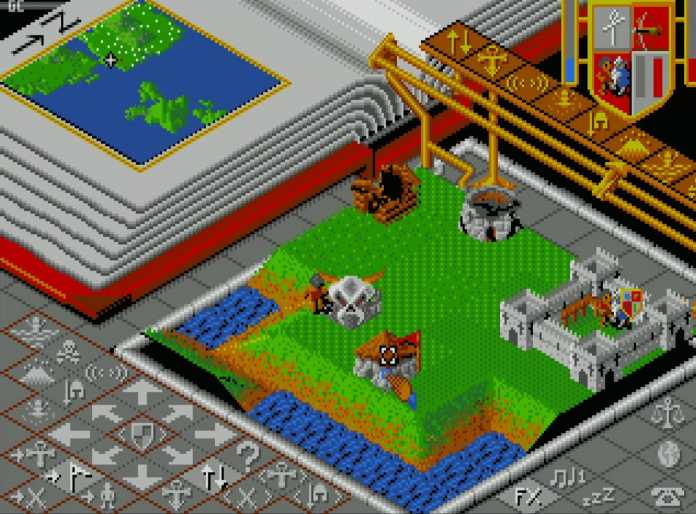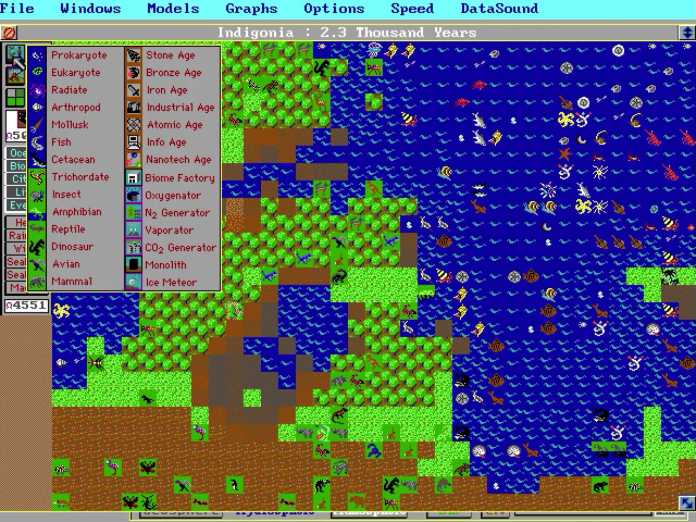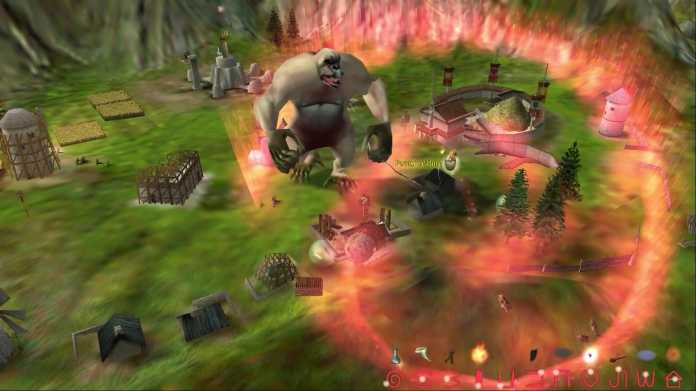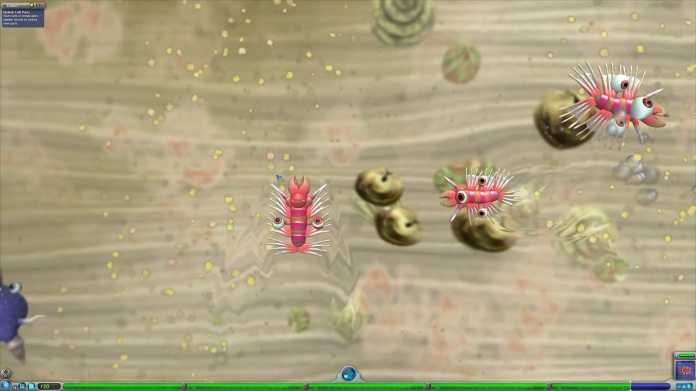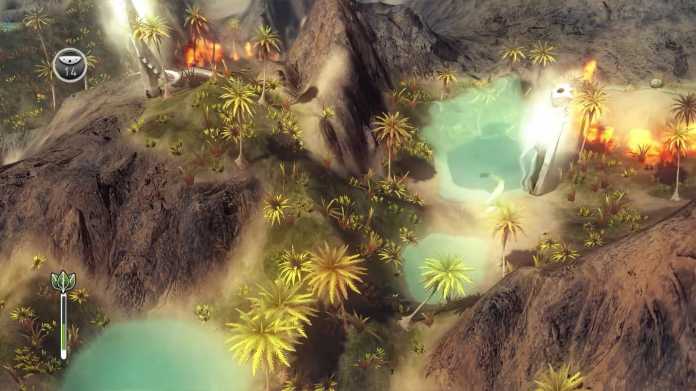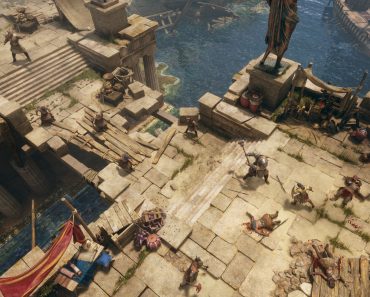In computer and video games, you very often take on the role of an overpowering being: Max Payne flies through the air in slow motion, B.J. Blazkowicz single-handedly wins the Second World War, Kratos slashes his way through the entirety of Greek mythology, including the underworld. This is nothing unusual, as “power fantasy” is an inherent part of the escapism idea of games.
The opportunity to play a real god, on the other hand, is much rarer. This probably has to do with the complexity of this very role: The ability to create land, life, entire universes at the snap of a finger from nothing sounds like a lot of work. Which is why the genre of god games is so pleasantly diverse.
What distinguishes a gods game from a typical strategy game or life simulation? It’s the details: in the classic god game, you don’t usually control troops or units to build bases or mine resources, but give these instructions indirectly, often in the form of a disembodied hand. The worshippers then take care of the best possible execution of these directives on their own. This is the most important distinction: In the Gods Game, you typically influence the masses by changing the world in their favor – readily using supernatural demonstrations of power. Here are a few selected examples of this unusual genre:
“Populous” (1989)
In the beginning was Peter. Peter Molyneux, to be precise. The father of the gods, if you like. Together with his Bullfrog colleagues Glenn Corpes and Les Edgar, he created the first real game of the gods in 1989: “Populous”. The name is derived from the Latin word for “people” and represents the central element of the game. In the role of an almighty god, it is the player’s task to make the virtual people who worship them flourish and prosper.
Raising and lowering the landscape enables the population to build settlements.
(Image: Electronic Arts)
You do this by raising and lowering land, thereby enabling the population to expand in the first place. At the same time, you have to make sure that the heavenly competition can’t do that. Which you do by inflicting evil plagues on the other nations – You are obviously still playing an Old Testament god here.
“Populous” is considered the prototypical god game, as it defined many of the standards that were typical of the genre for a long time afterwards: Isometric graphics, the divine hand as a cursor, little pixel figures that move autonomously through the landscape and automatically build settlements as soon as the required space is available. It was also intended to cement the reputation of Bullfrog Productions and Peter Molyneux as one of the most important producers of god games, which led to offshoots with similar gameplay such as “Powermonger” (1990) or “Godus” (2013) and also direct successors such as “Populous 2” (1991) or “Populous: The Beginning” (1998).
Available at: GOG, Steam
“SimEarth” (1990)
Strictly speaking, Maxis’ “Sim” titles are not god games. You do not assume supernatural power in them, you are not worshipped, mana plays no role. In terms of content, however, the proximity to the typical god game is obvious, and nowhere is this clearer than in the 1990 SimCity successor “SimEarth”.
“SimEarth” may look dry, but behind the brittle surface hides a profound gaming experience.
(Image: Maxis)
This was no longer about building a perfectly purring metropolis, but about using evolution to ensure the flourishing of an entire planet. Sentient life is created here by influencing the climate or the geological characteristics of the planet. If the guided evolution progresses successfully enough, a civilization is formed whose ultimate goal is to leave the planet alive before the sun explodes.
“SimEarth” neglects the spiritual side of the typical god game and emphasizes the scientific aspect all the more, but is still considered one of the most important milestones of the genre. With this game, Maxis established itself as the somewhat more grounded antithesis to Bullfrog’s fantasies of omnipotence, which would later lead to games such as “SimLife” (1992) or “The Sims” (2000).
“Afterlife” (1996)
A game of the gods that wasn’t developed by Bullfrog or Maxis? Is that even allowed? The exact legal situation has yet to be researched, but LucasArts’ 1996 “Afterlife” was definitely very entertaining. It’s about controlling the heaven and hell of an extraterrestrial civilization. In each of these levels, a functioning infrastructure must be ensured and, above all, it must be ensured that the constantly arriving souls of the deceased end up in the correct afterlife.
Is this how you imagine heaven or hell? The deceased souls have to be entertained somehow…
(Image: LucasArts)
“Afterlife” was also not a typical game about gods; in terms of content, it was more in the vein of classic economic and construction simulations such as “SimCity 2000” (1993). However, it introduced a feature into the game that would later turn out to be an elementary pillar of the genre, namely the divine advisors, here in the form of angel Aria and demon Jasper, who guide you through the game and give you clever tips time and again.
Available from: GOG, Steam
“Black & White” (2000)
At the end of the 90s, there was hardly a game that caused a bigger fuss than “Black & White”, the debut work of Lionhead Studios, the new game company of Peter Molyneux, who left his own company in frustration shortly after the release of “Dungeon Keeper” (itself also a relevant god game).
“Black & White” was of course unable to fully meet all the expectations that had been raised by years of development diaries published in the gaming magazines and enthusiastic previews. But it did a lot of things very right and is now regarded as the quintessential game of the gods: In the form of an all-powerful hand, you determine the fate of your worshippers, a gigantic creature embodies the kind of god you want to be – benevolent, wrathful, helpful or destructive, “Black & White” gave you complete freedom of expression.
The appearance of your creature depends on your divine activities, among other things.
(Image: Electronic Arts)
The creatures in particular, such as the gigantic cow, monkey, lion or turtle, which change not only in character but also visually over the course of the game depending on training and god behavior, were a milestone in development that would set standards for years to come. At least until 2005, when the game’s official successor was released.
“Spore” (2008)
Just like “SimEarth”, “Spore”, from the hands of Will Wright, is a life simulation – that gives you a lot of divine power. In this case, the power to create life and develop it in any direction, no matter how absurd.
In Spore, the adventure begins in the world of single-celled organisms. The creatures quickly become minimally more complex.
(Image: Electronic Arts)
It all begins with a single-cell organism, from which a galaxy-travelling civilization is to develop over the course of many millions of years of guided evolution. In terms of gameplay, the whole thing was never fully developed and tends to get bogged down in many unnecessary minutiae. But the core content of Spore, which is based on procedural generation like later games such as “No Man’s Sky” (2016), is just as fascinating today as it was back then.
Available from: GOG, Steam
“From Dust” (2011)
Eric Chahi is best known as the developer of the dexterity masterpiece “Another World” (1991). But the lively Frenchman has even more classics under his belt. Not the adventure game “Future Wars” (1989), although that was also really good. No, we’re talking about his 2011 god game “From Dust”, which he himself described as a spiritual successor to “Populous”.
“From Dust” sees itself as a modern Populous.
(Image: Ubisoft)
Here, as there, you use your divine omnipotence to control the landscape to give your subjects a reasonably relaxed life and clear the way to a totem pole. Unlike in “Populous”, however, this is less about raising and lowering the ground. Instead, you can manipulate lava, water and sand to change mountains or divert tsunamis, for example. All in chic 3D graphics and (for the time) very impressive use of physics.
A special aspect of “From Dust” is that, unlike most other god games, it is not based on the typical Western depictions of gods, but instead takes various primitive peoples as its model.
Available from: Steam, Ubisoft
These were just a few selected examples of the very rich genre of god simulation. There are many other games that deal more or less directly with the divinity of the player. Such as “Little Computer People”, “Dungeon Keeper”, “Actraiser”, “Sacrifice”, “Darwinia”, “Doodle God”, “Majesty”, “The Universim” or “Worldbox: God Simulator”. We hope you enjoy the apotheosis.
(vza)


